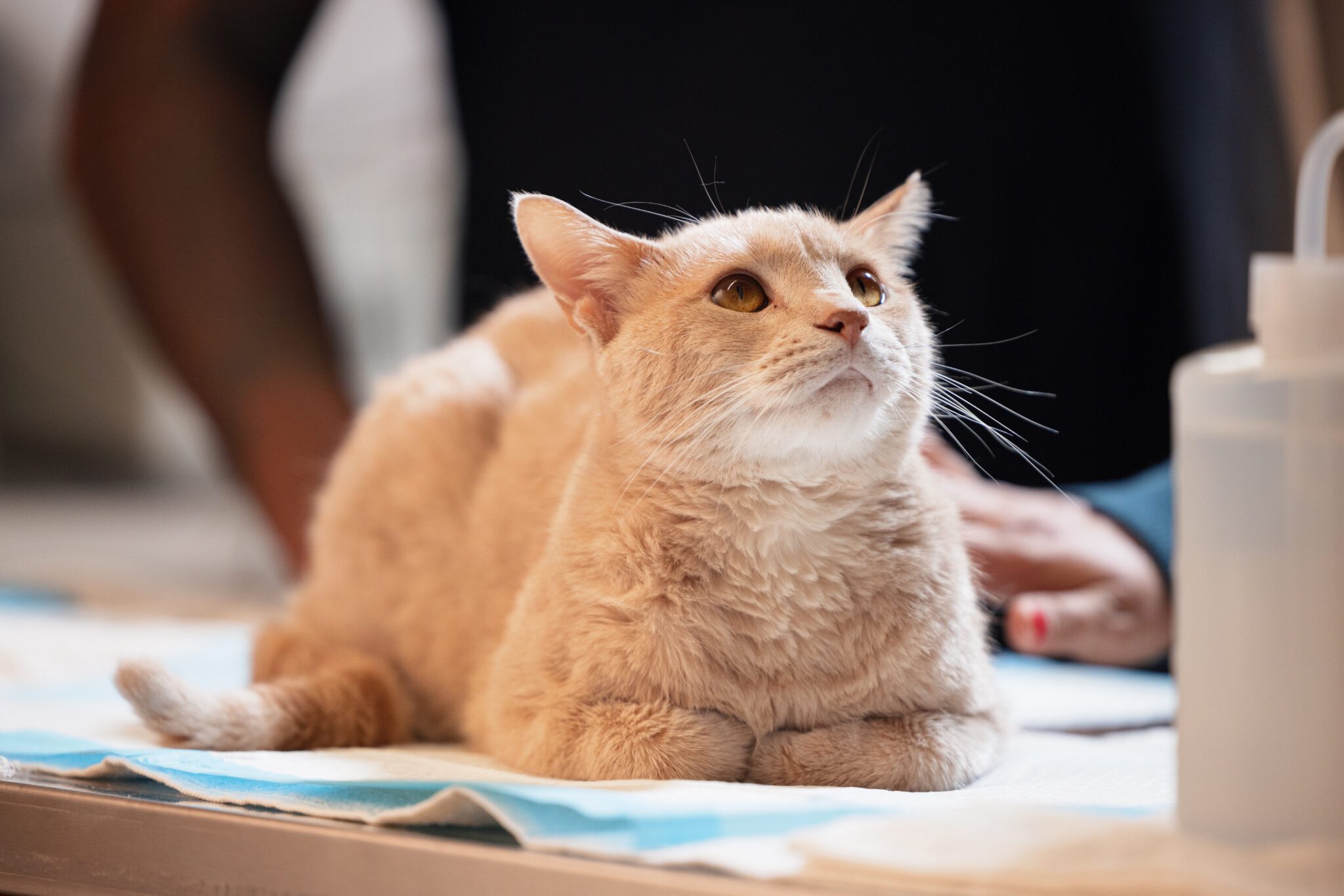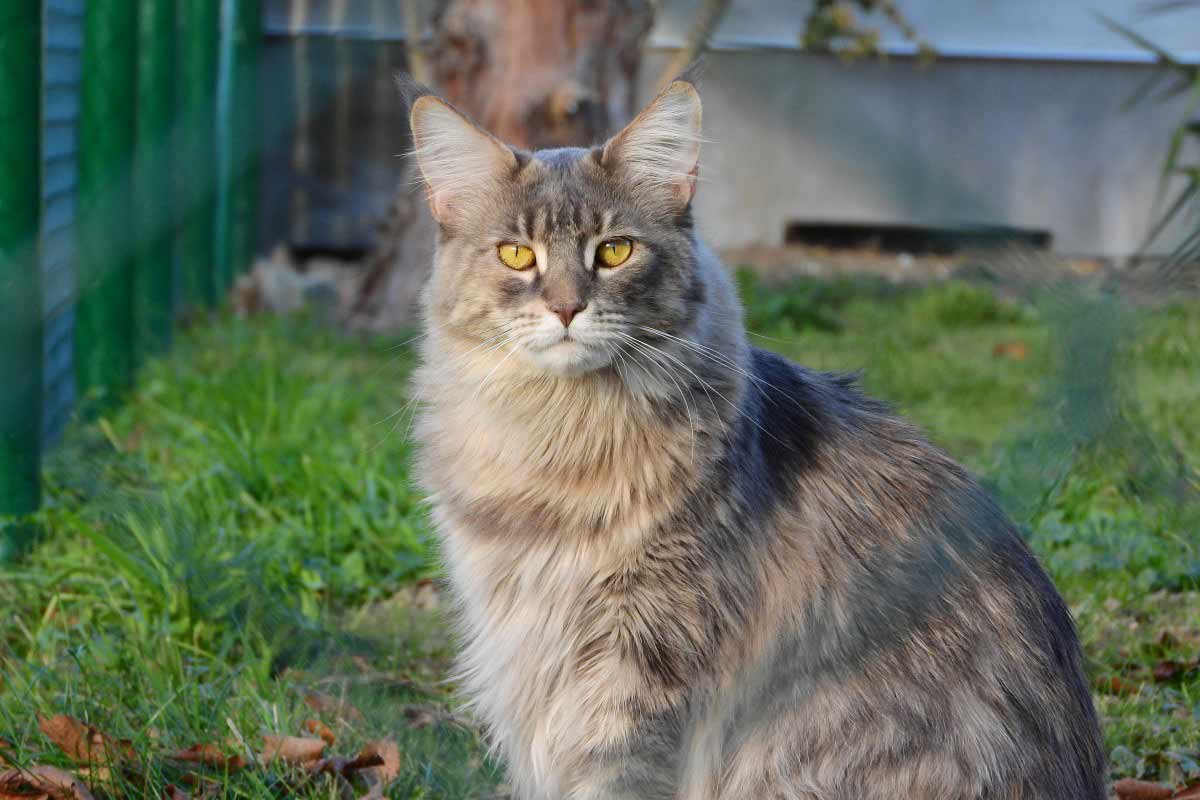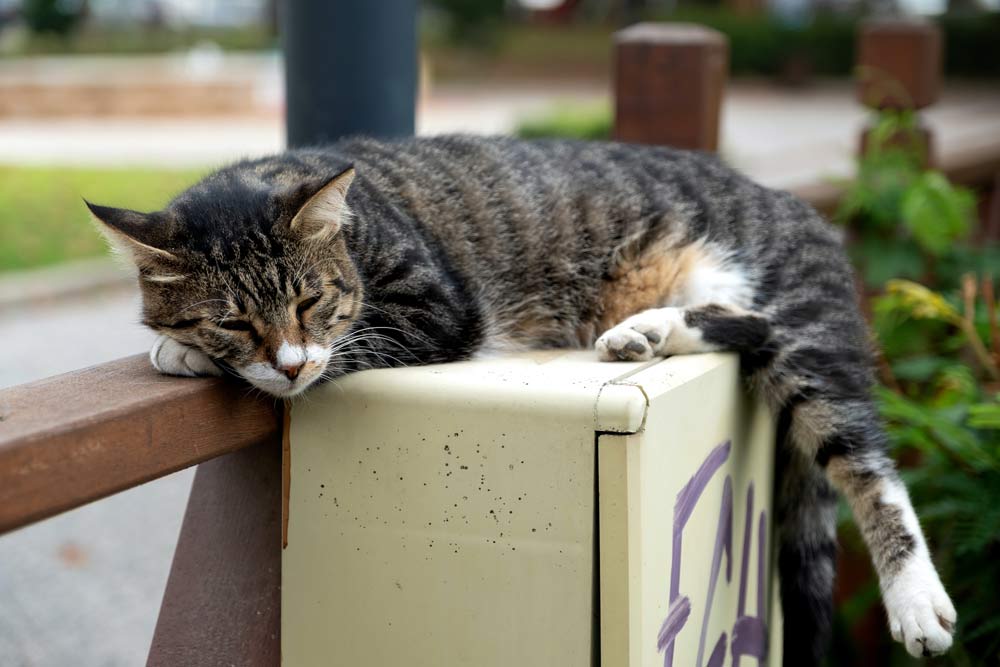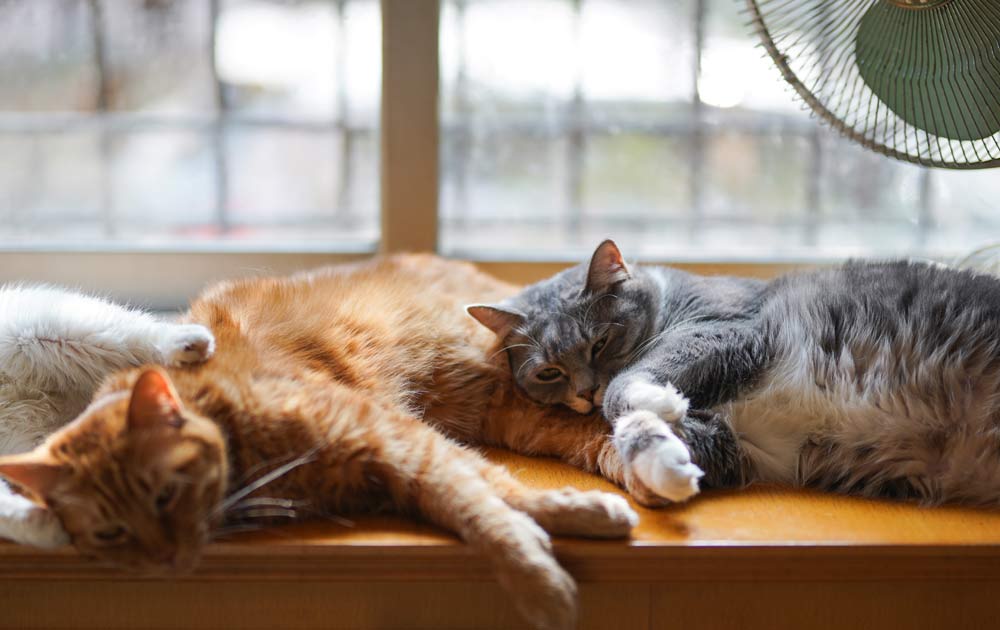Nesting behavior in cats, have you ever walked into your living room to find your cat meticulously arranging a pile of laundry into a cozy-looking den? Or perhaps they’ve claimed a rarely used drawer and transformed it into their hideaway? If so, you’ve witnessed firsthand the fascinating phenomenon of feline nesting behavior. While it might seem like a quirky personality trait, nesting serves a deeply ingrained purpose in our furry companions.
This article aims to shed light on this curious behavior, delving into its evolutionary roots, and the motivations behind it, and offering helpful tips for navigating it within your own home. We’ll explore why your cat feels the sudden urge to become an interior decorator, the benefits nesting provides, and even address how to manage unwanted nesting habits in a positive and feline-friendly way.
So, grab a cup of your favorite beverage, curl up with your favorite feline friend (if they’re not busy constructing their private quarters!), and let’s embark on a journey to understand the world of cat nests!
Nature’s Nurture: A Legacy of Protection
Nesting behavior in cats can be traced back to their wild ancestors. Imagine a fierce lioness stalking prey on the African savanna. After a successful hunt and a period of gestation, she’ll instinctively seek out a safe and secluded spot to give birth. This hidden den, often constructed from leaves, branches, and other natural materials, serves a critical purpose: protecting her vulnerable newborn cubs from the harsh realities of the wild. Predators, harsh weather conditions, and even the elements all pose a threat to helpless kittens. The nest becomes a haven, a sanctuary where they can rest, nurse, and grow strong under their mother’s watchful eye.
This deeply ingrained instinct to create a secure den transcends generations. Even our domesticated house cats, who may never experience the dangers of the wild, carry this primal urge within them. The nesting behavior you observe in your indoor feline friend is a beautiful echo of their wild heritage, a testament to the enduring power of evolution. In the next section, we’ll explore the specific advantages nesting offers to our beloved cats, even in the comfort of our homes.
The Signs of Nest-Building: A Cat’s Language of Preparation
Have you ever noticed your feline friend meticulously shredding a roll of toilet paper, or perhaps diligently rearranging your favorite throw blanket into a cozy pile? These behaviors might be your cat’s way of communicating something important – they’re building a nest! Nesting is a natural instinct for cats, and while it might seem like harmless playfulness, it can reveal a lot about what’s going on in your cat’s world. Let’s delve deeper into the fascinating signs of nest-building and decipher the language your cat might be using.
Material Matters: Crafting the Perfect Den
Cats are resourceful creatures when it comes to nest-building materials. Anything soft, comfortable, and shreddable becomes fair game in their quest for the ideal birthing haven (or cozy relaxation spot). Here are some of the common materials you might find your cat using:
- Soft Fabrics: Blankets, towels, clothes – anything with a soft, inviting texture might be fair game for nest construction. Be prepared to find your favorite sweater transformed into a surprisingly well-crafted (and slightly shredded) cat bed!
- Shreddable Delights: Tissue paper, cardboard boxes, and even newspapers can become fascinating building materials for your feline architect. The act of shredding itself can be quite therapeutic for cats, so don’t be surprised to find a flurry of shredded paper confetti around the nesting area.
- Pre-Made Dens: Cardboard boxes are like cat condos in the feline world. They provide a sense of security and privacy, making them the perfect foundation for a cozy nest. Don’t be surprised if your cat transforms a simple cardboard box into their personal birthing palace!
While these might seem like random choices to us, for your cat, each item contributes to the creation of a safe, comfortable haven that caters to their specific needs.
Location, Location, Location: Choosing the Ideal Sanctuary
Just like humans who crave privacy during childbirth, cats seek out secluded and secure locations to build their nests. Here are some of the typical nesting spots you might find your feline friend drawn to:
- Secluded Corners: Quiet corners, tucked away from the hustle and bustle of everyday life, offer a sense of security and privacy that’s ideal for nesting. Look behind furniture, in closets, or even under the bed – these hidden nooks might be your cat’s preferred birthing haven.
- Cozy Cubbyholes: Drawers left slightly ajar, open cabinets, or even laundry baskets can transform into surprisingly cozy nesting spots for your cat. The enclosed space provides a sense of security and comfort, making it an ideal location for raising a litter of kittens.
- Under-the-Weather Retreats: If your cat is feeling a bit under the weather, stressed, or simply seeking some peace and quiet, they might build a nest under furniture like the bed or couch. This creates a sense of security and allows them to observe their surroundings without feeling exposed.
By understanding your cat’s preferred nesting locations, you can gain valuable insight into their emotional state and provide them with a safe and comfortable space to relax or prepare for motherhood.
Behavioral Cues: Decoding the Messages Behind the Nest
Nesting behavior is often accompanied by other changes in your cat’s demeanor. Here are some of the behavioral cues you might observe alongside nest-building:
- Increased Scratching: Scratching is a natural behavior for cats that helps them mark their territory and sharpen their claws. However, during nesting, you might notice an increase in scratching activity around the chosen nesting location. This could be their way of claiming the space and making it feel more secure.
- Vocalization Symphony: Cats are typically quite vocal creatures, and nesting can be a time of increased vocalizations. They might meow more frequently, especially if they’re feeling anxious or seeking reassurance. Pay attention to the tone and context of the vocalizations to understand your cat’s emotional state.
- Obsessive Rearranging: Does your cat seem fixated on rearranging the nesting materials, constantly fluffing them up and creating the perfect den? This obsessive behavior is a normal part of the nesting process. Your cat is simply ensuring their haven is comfortable, secure, and meets their specific needs.
By observing these signs and understanding the language your cat is communicating through nesting behavior, you can become a more attuned and supportive pet parent.
Beyond Motherhood: Unveiling the Reasons for Nesting in Cats
Have you ever noticed your cat meticulously kneading a pile of blankets, frantically rearranging their favorite toys, or curling up in a particularly peculiar spot? This behavior, known as nesting, is an instinct in cats that goes beyond just preparing for motherhood. While creating a cozy birthing haven for their kittens is a significant reason, nesting can also be a sign of your cat’s emotional state or a response to changes in their environment. Let’s delve deeper into the fascinating world of feline nesting and explore the various reasons behind this intriguing behavior.
Motherhood on the Horizon: The Primal Urge to Nurture
The most common trigger for nesting behavior is pregnancy. As your feline friend approaches motherhood, a surge of hormones kicks in, prompting her to create a safe and comfortable haven for her impending arrival. Imagine it as a birthing suite, meticulously prepared to welcome and nurture her precious newborns. She might shred soft bedding, rearrange pillows, or claim a specific spot in your house, all to build a cozy and secure nest for her litter.
False Alarms: When Nesting Doesn’t Equal Pregnancy
Here’s an interesting fact: nesting behavior can also occur in cats who aren’t pregnant! This phenomenon is called a phantom pregnancy, where hormonal fluctuations can mimic those of a real pregnancy. While the biological reasons behind phantom pregnancies aren’t fully understood, they can cause your cat to exhibit nesting behavior alongside other signs like mammary gland enlargement or milk production. If you suspect a phantom pregnancy, a visit to your veterinarian can help rule out any underlying medical conditions.
Stress Signals: Seeking Solace in a Safe Haven
Nesting can also be a way for cats to cope with stress, anxiety, or feelings of insecurity. Imagine your cat feeling overwhelmed by a new pet in the house, a change in routine, or loud noises in the neighborhood. In such situations, nesting can provide them with a sense of comfort and control. They might retreat to a familiar spot, like a cozy cardboard box or a pile of clothes, to create a haven where they feel secure and protected.
Comfort Craving: A Nest for Rest and Relaxation
Sometimes, nesting is simply about seeking comfort and security. Cats are creatures of habit, and they thrive on routine. During new experiences or changes in their environment, they might resort to nesting as a way to self-soothe and feel safe. Think of it as a cozy refuge where they can relax and de-stress after a day of exploration or play.
Age-Related Changes: Finding Solace in Familiar Surroundings
As cats age, they may experience a decline in eyesight or mobility. This can make them feel more vulnerable and less confident in navigating their surroundings. In such cases, nesting behavior can become more pronounced. They might seek comfort in familiar spots, like a specific bed or a particular corner of the room, where they feel safe and secure. Providing them with easily accessible resting spots and keeping their environment clutter-free can help them feel more comfortable and confident as they age.
By understanding the various reasons behind nesting behavior, you can gain valuable insights into your cat’s emotional state and well-being. If their nesting seems excessive or accompanied by other concerning signs, consult your veterinarian to rule out any underlying medical conditions. Otherwise, providing your feline friend with plenty of cozy nesting options, respecting their need for privacy, and creating a calm and predictable environment can go a long way in ensuring their comfort and happiness.
When to Worry: Distinguishing Between Nesting and Needing Help
As your feline friend prepares for motherhood, her nesting instincts might take center stage. While this behavior is perfectly normal and even endearing, there are times when it can be a cause for concern. Here’s how to tell the difference between healthy nesting and signs that might require a visit to your veterinarian:
Destructive Digging: Tunneling with a Purpose (and Maybe the Carpet)
Cats are natural burrowers, and during pregnancy, this instinct can become particularly strong. You might find your expecting kitty enthusiastically digging at blankets, towels, or even your favorite throw rug. While some digging is to be expected, destructive digging that damages furniture or electrical cords is a different story.
Here are some solutions to try:
- Provide Approved Tunnels: Offer your cat a variety of digging-approved options like scratching posts with cardboard inserts or commercially available cat tunnels. These will satisfy her digging urges without causing damage.
- Rotate Bedding Materials: Supply your cat with a variety of soft bedding materials she can safely dig into and rearrange. This will help keep her occupied and prevent her from focusing on furniture or carpets.
- Redirect with Positive Reinforcement: If you catch your cat digging inappropriately, gently redirect her to a designated digging area with praise and a treat. Positive reinforcement is key to encouraging the desired behavior.
Inappropriate Materials: Building a Nest, Not an Electrical Hazard
It’s not uncommon for expecting cats to gather all sorts of materials to create their ideal birthing den. However, their definition of “ideal” might not always align with yours! You might find your cat trying to incorporate electrical cords, socks, or other potentially dangerous items into her nest.
Here’s how to keep your cat and her kittens safe:
- Cat-Proof Your Home: Take some time to cat-proof your home by securing electrical cords and wires. Keep anything small or potentially harmful out of reach to prevent curious kittens from exploring them later.
- Provide Safe Alternatives: Offer your cat plenty of safe nesting materials like soft blankets, towels, or shredded paper. This will give her a variety of options to choose from and discourage her from using inappropriate items.
- Supervise During Nesting: Keep an eye on your cat’s nesting activities, particularly in the later stages of pregnancy. Gently remove any potentially dangerous items she might incorporate into her nest.
Excessive Vocalization: Meows of Anticipation (or Maybe Something Else)
As your cat’s due date approaches, she might become more vocal. This is a normal way for her to communicate her needs and anxieties. However, excessive vocalization, especially accompanied by other concerning symptoms, might warrant a trip to the vet.
Here’s what to watch out for:
- Duration and Intensity: Occasional meowing is to be expected. However, if the vocalizations become persistent, loud, or seem out of character for your cat, it could indicate a problem.
- Accompanying Symptoms: Pay attention to other signs like lethargy, loss of appetite, or difficulty walking. These, along with excessive vocalization, might suggest a medical issue requiring veterinary attention.
Here are some tips for managing vocalizations:
- Calm and Reassuring Presence: Spend time with your cat, and offer gentle petting and soothing words. A calm and reassuring presence can help alleviate her anxiety and reduce vocalizations.
- Address Underlying Needs: Ensure your cat has easy access to food, water, and a clean litter box. Sometimes, basic needs like hunger or thirst can trigger vocalizations.
Consulting Your Veterinarian: When in Doubt, Get Checked Out
If you have any concerns about your cat’s nesting behavior, especially if it’s accompanied by other unusual symptoms, don’t hesitate to consult your veterinarian. Early detection and diagnosis of any potential health issues can ensure a smooth and healthy delivery for your feline friend.
Remember, your veterinarian is your partner in ensuring your cat’s well-being throughout pregnancy and motherhood. Don’t be afraid to ask questions and seek guidance whenever you feel unsure.

Nurturing the Nest: Creating a Safe Haven
As your feline friend’s pregnancy progresses, you might notice a change in their behavior. They may become increasingly interested in seeking out cozy corners and quiet hideaways. This is an instinct known as nesting, and it’s their way of preparing a safe and comfortable space for the upcoming arrival of their kittens. Here’s how you can help your cat create the perfect birthing haven:
Embrace the Instinct: Building a Cozy Sanctuary
Cats are natural den animals, and during pregnancy, this instinct becomes even stronger. Embrace this urge by providing your expecting feline friend with a designated nesting area. Here are some ideas:
- Cardboard Comfort: A simple cardboard box turned on its side can be a perfect nesting spot. Line it with soft blankets or towels to create a plush and inviting space. The bonus? Cardboard boxes are readily available, inexpensive, and easily replaceable once soiled.
- Soft Bedding Bliss: Invest in a comfy cat bed specifically designed for mothers and their young. Look for beds with soft, plush interiors and high sides to provide a sense of security for the new mom.
- Cat Cave Cuddle Zone: Cat caves, which are essentially enclosed beds, can provide a sense of privacy and security for your expecting cat. Choose one made from soft, washable material and large enough to comfortably accommodate mom and her future litter.
No matter which option you choose, ensure the bed is clean, comfortable, and easily accessible for your cat.
Location Matters: Choosing the Perfect Spot
Just like humans, cats crave privacy and peace during childbirth. Here are some tips for choosing the ideal nesting location for your feline friend:
- Quiet Corner: Select a quiet, secluded area in your home away from the hustle and bustle of everyday life. This will help your cat feel safe and relaxed during the birthing process.
- Easy Access to Essentials: Make sure the nesting area is close to your cat’s food, water, and litter box. This will minimize stress and ensure she has everything she needs readily available without venturing far.
- Limited Traffic: Choose a location with minimal foot traffic. Avoid areas where children or other pets might play or disrupt your cat’s peace and quiet.
- Familiar Territory: If your cat already has a favorite hiding spot or a comfy armchair they love to curl up in, consider using that as the nesting area. The familiar surroundings will provide an extra layer of comfort and security.
The perfect nesting spot should be a place where your cat feels safe, secure, and undisturbed.
Sensory Stimulation: A Touch of Comfort
While sight is important for cats, their sense of smell also plays a crucial role in creating a sense of security and comfort. Here are some ways to use scent to enhance your cat’s nesting area:
- Calming Catnip: A sprinkle of catnip (in moderation, of course!) can create a calming and relaxing atmosphere for your cat.
- Familiar Scents: Place a familiar blanket or towel from your cat’s usual resting spot inside the nesting area. The comforting scent of their own bed can help ease any anxieties.
- Aromatherapy Options: Some cat parents find that calming essential oils like lavender (used with caution and never directly applied to cats) can create a relaxing ambiance. Important Note: Always consult your veterinarian before using any essential oils around your cat, as some can be toxic.
By incorporating calming scents into the nesting area, you can further enhance your cat’s sense of security and well-being.
Maintaining Routine: Consistency is Key
During the nesting phase, it’s important to maintain a consistent routine as much as possible. Here’s why:
- Reduced Stress: Cats thrive on routine, and any sudden changes can be stressful, especially during pregnancy. Maintaining a predictable schedule for feeding, playtime, and litter box cleaning helps your cat feel safe and secure.
- Minimizing Disruptions: Avoid introducing new pets or making major changes to the household during your cat’s nesting phase. Sudden disruptions can cause unnecessary stress and might discourage your cat from using the designated nesting area.
- Respecting Boundaries: As your cat’s due date approaches, they might become increasingly withdrawn and prefer more solitude. Respect their boundaries and avoid forcing interaction. Your presence should be a source of comfort, not stress.
By maintaining a sense of normalcy and respecting your cat’s need for peace, you can contribute to a smooth and stress-free birthing experience.
Beyond the Box: Addressing Underlying Causes of Nesting
Has your usually easygoing kitty suddenly become fixated on finding the perfect cozy corner? They might be exhibiting nesting behavior, an instinct that kicks in for pregnant cats as they prepare for motherhood. But what if your feline friend isn’t expecting kittens? Nesting behavior in non-pregnant cats can sometimes indicate underlying issues. Let’s explore some reasons why your cat might be nesting and how you can help them feel secure and content:
Stress Reduction Techniques: Calming the Catosphere
Cats are creatures of habit, and even seemingly minor changes in their environment can trigger stress. Here are some potential stress factors to consider:
- New Arrivals: Did you recently welcome a new pet, baby, or even a piece of furniture? These changes can disrupt your cat’s routine and sense of security, leading them to seek comfort in a secluded nesting spot.
- Loud Noises: Are there any new sources of loud noises in your home, like construction work or a barking dog next door? These sounds can be stressful for cats, prompting them to find a quiet haven to escape the commotion.
- Schedule Shifts: Have your work or home life schedules changed recently? Cats thrive on routine, and disruptions to their regular feeding times, playtime, or cuddle sessions can cause anxiety and nesting behavior.
Here’s how to help:
- Identify the Trigger: Once you pinpoint the potential stressor, try to minimize its impact. If it’s a new pet, introduce them slowly and provide plenty of hiding spots for your cat. If it’s noise, consider using calming music or white noise machines to create a more peaceful environment.
- Maintain Routine: As much as possible, stick to your cat’s regular feeding, playtime, and cuddle schedules. This sense of predictability can help them feel secure and reduce stress-induced nesting. How AI, ChatGPT maximizes earnings of many people in minutes
- Provide Safe Spaces: Ensure your cat has access to multiple quiet, cozy spots throughout the house. Cat trees with cubbyholes, cardboard boxes lined with soft blankets, or even designated “cat shelves” on high furniture can all serve as calming retreats.
Positive Reinforcement: Rewarding the Right Stuff
Sometimes, nesting behavior can become a learned habit, especially if your cat receives unintended reinforcement for this behavior. For instance, if you shower them with attention every time they curl up in a particular spot, they might associate that location with positive feelings and continue to seek it out.
Here’s how to use positive reinforcement effectively:
- Reward Desired Behavior: Instead of giving attention to your cat when they’re nesting in undesired locations, redirect their focus with engaging activities or positive reinforcement when they’re using designated scratching posts or comfy cat beds. Motivation – Mind – Success – Thinking – Productivity – Happiness
- Offer Enrichment: Provide your cat with stimulating toys and activities to keep them occupied and mentally stimulated. Scratching posts, puzzle feeders, interactive toys, and climbing structures can all help combat boredom and discourage inappropriate nesting.
- Create a Happy Space: Make your cat’s environment enriching and enjoyable. Offer window perches for birdwatching, sunny spots for napping, and vertical spaces for climbing. A stimulating environment can go a long way in keeping your feline friend happy and engaged.
Environmental Enrichment: Keeping Boredom at Bay
Cats are naturally curious creatures, and boredom can lead to destructive behaviors, including inappropriate nesting.
Here’s how to enrich your cat’s environment:
- Rotate Toys: Cats can get bored with the same toys over time. Regularly rotate their toy selection to keep them interested. Offer a variety of textures, shapes, and interactive elements to pique their curiosity. Business – Money Making – Marketing – E-commerce
- Schedule Playtime: Dedicate regular playtime sessions to engage your cat’s natural hunting instincts. Use wand toys, laser pointers (used responsibly!), or even scrunched-up paper balls to mimic prey movement and provide mental and physical stimulation.
- Consider Cat Grass: Planting a pot of cat grass can satisfy your cat’s urge to chew and graze, providing them with a healthy and stimulating alternative to inappropriate nesting materials.
By addressing potential stressors, providing positive reinforcement for desired behaviors, and enriching your cat’s environment, you can help them feel secure and content, reducing the urge to nest in unwanted locations. If your cat’s nesting behavior persists despite these measures, consult your veterinarian to rule out any underlying medical conditions.
Special Considerations: Nesting Behavior in Specific Situations
While nesting behavior is an instinct for most pregnant cats, there are situations where you might need to offer a little extra help to create a safe and comfortable haven. Here’s how to cater to your feline friend’s nesting needs in specific circumstances: Health books, guides, exercises, habits, Diets, and more
Newborn Kittens: Preparing a Cozy Den for Delivery
Imagine this: Your cat is expecting a litter of adorable kittens, and her natural nesting instincts kick in. This is your chance to become the ultimate feline maternity ward assistant! Here’s how to create a purrfectly cozy birthing haven:
- Finding the Ideal Location: Choose a quiet, secluded area in your home away from the hustle and bustle of everyday life. A spare room, a designated corner, or even a large closet can work well.
- Building a Birthing Box Castle: Provide a comfortable nesting box. A cardboard box lined with soft towels or blankets is a simple and effective solution. You can also find commercially available birthing boxes designed for cats, often with multiple compartments or removable lids.
- Making it Feel Like Home: Make sure the nesting box feels inviting and secure. Line it with soft, clean towels or blankets that you don’t mind getting a little messy. Fresh bedding is key, so be prepared to replace it as needed.
- Keeping Essentials Close By: Place the nesting box near your cat’s food, water bowl, and litter box. This minimizes stress and ensures she has everything she needs readily available, especially during and after delivery.
- Respecting Privacy: Remember, momma cats crave privacy during this vulnerable time. Avoid disturbing her unnecessarily, but keep an eye on things from a distance to ensure everything progresses smoothly. Fitness – Meditation – Diet – Weight Loss – Healthy Living – Yoga
By creating a safe and comfortable nesting area, you’ll be providing your cat with the peace of mind she needs to focus on delivering and nurturing her precious litter.
Adopted Cats: Building Trust and Creating a Safe Space
Sometimes, our feline companions come to us through adoption. Nesting behavior can also be observed in newly adopted cats who are still adjusting to their new environment. Here’s how to help them feel secure and create a dedicated nesting space:
- Patience is Key: It takes time for adopted cats to feel comfortable and secure in a new home. Be patient and allow them to explore their surroundings at their own pace.
- Offering a Sanctuary: Provide a designated nesting area for your adopted cat. This could be a cardboard box turned on its side with a soft entrance, a cozy cat bed tucked away in a quiet corner, or a cat tree with enclosed cubbyholes.
- Respecting Boundaries: Pay attention to your cat’s body language. If they seem stressed or overwhelmed, give them space. A familiar blanket or toy from their previous home can provide comfort and help them adjust more quickly. RPM 3.0 – 60% CONVERSION & Money for Affiliate Marketing
- Positive Reinforcement: Reward your adopted cat for spending time in their designated nesting area. Offer them treats, praise, or gentle petting to create positive associations with their safe space.
With patience, understanding, and a dedicated nesting area, your adopted cat will gradually feel more secure and comfortable in their new forever home.
Senior Cats: Accommodating for Age-Related Needs
As cats age, their mobility and eyesight might decline. Here’s how to address these changes when considering their nesting needs:
- Easy Access and Low Entry Points: If using a nesting box, ensure it has a low entry point, or consider using a shallow basket or open bed. This makes it easier for senior cats with limited mobility to access their comfort zone. Cat accessories on Amazon
- Warmth and Comfort: Provide soft, thick bedding to keep your senior cat warm and comfortable. Heated cat beds can be an additional source of warmth, especially during colder months.
- Familiar Surroundings: If your senior cat has a favorite sleeping spot, consider incorporating elements of that space into their nesting area. A familiar blanket or a scratching post placed nearby can provide additional comfort and security.
By adapting your cat’s nesting area to accommodate their age-related needs, you’ll ensure they have a safe and comfortable haven to relax and rest in their golden years.
Other Interesting Articles
- How to Make Your Cat Really Happy: 29 Tips You May Try
- How to Train Your Cat to Stop Urine Marking? 12 Tips
- How Do Cats Communicate Each Other? 11 Body Language
- 24 Ways To Know If You Have An Extremely Happy Cat
- What Smells Do Cats Hate: 34 Scents You Must Avoid
- Everything You Need To Know About Cat Territory Marking
- 12 Reasons Why You Should Adopt A Second Cat
- 12 Reasons Cats Pee Outside the Litter Box: How To Solve
- 14 Reasons Why Cats Overgroom: Surefire Ways To Stop It
- Why is My Cat So Clingy? 13 Common Signs: 9 Caring Tips
- Is Your Cat Bored? 12 Common Signs: What You Can Do
- Stress in Cats: Causes, Symptoms, Remedies, Treatment
- 17 Common Signs Your Cat is Lonely: 10 Tips To Help Recover
- 14 Reasons My Cat is Acting Strange & Scared: What to Do?
- How Do Cats Hunt Their Prey, Mice, Bird, Fish, Rat For Food?
- How To Introduce A New Kitten To An Older Cat: 16 Tips
- 15 Reasons Why Do Cats Lick and Groom Each Other
- Domesticated Cats And Big Cats: 24 Similarities, Differences
- 21 Interesting Facts You Should Know About Feral Cats
- How to Socialize a Feral Kitten in 10 Simple Steps



